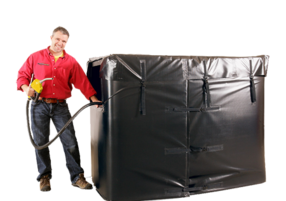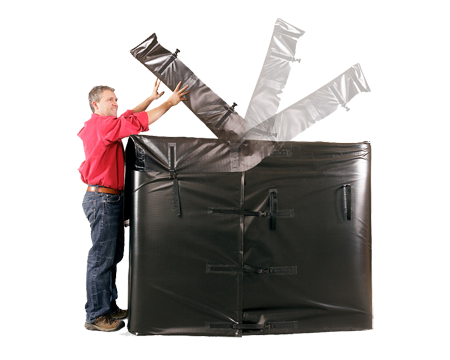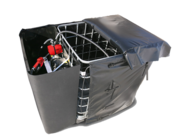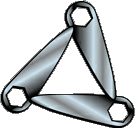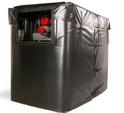Store Logins
POWERBLANKET DEF TOTE
HEATER
Email shannon@tricityindustrial.com Phone 509-554-6561
Fax 509-380-5789
The Powerblanket Def Tote Heater protects your diesel exhaust fluid from freezing in cold weather.
DEF TOTE HEATER 275 GALLON
The most cost effective and energy efficient method for protecting DEF from the cold. Keeps DEF at an optimal temp of 75 degrees. Lightweight heated enclosure is engineered to protect the pump housing, hoses, nozzles, valves, and holding tanks from freezing. Click here for more info.
DEF TOTE HEATER 330 GALLON
The most cost effective and energy efficient method for protecting DEF from the cold. Keeps DEF at an optimal temp of 75 degrees. Lightweight heated enclosure is engineered to protect the pump housing, hoses, nozzles, valves, and holding tanks from freezing. Click here for more info.
$2598.75
$2,950.00
Q. What is Diesel Exhaust Fluid (DEF)? A. DEF is the reactant needed for the purpose of the Selective Catalytic Reduction system (SCR) used to decrease NOx concentration. It is a mixture of aqueous urea solution of 32.5% high purity urea and 67.5% DI water.
Q. What is urea? A. Urea is a nitrogen compound that turns to ammonia when it’s heated. Urea has significant uses as a fertilizer and as feed supplement, as well as a starting material for the produce of plastics and drugs. It is a colorless, crystalline substance that melts at 132.7° C (271° F) and decomposes before boiling.
Q. How does DEF work within a SCR system? A. The SCR technology goes into gas exhaust downstream of the engine. A small quantity of DEF is put into the exhaust stream and when it is mixed with the NOx, it changes into harmless nitrogen and water.
Q. How will I know that the DEF product I purchase will work? A. The DEF you purchase should display the American Petroleum Institute (API) certification, the International Organization for Standardization ISO 22241-1, & meet AUS – 32 specifications. This will guarantee the appropriate purity and concentration (32.5%) of urea. If you want to learn more, please visit www.iso.org.
Q. What is the chemical process of producing urea and what is the energy balance of this process? A. The production of urea involves the raw materials of ammonia and carbon dioxide. Two reactions take place in the formation of urea; exothermic (heat releasing) reacts with ammonia + carbon dioxide and makes ammonium carbamate. The second reaction is an endothermic (absorbing energy within heat) which reacts with ammonium carbamate and is changed into water plus urea.
Q. Is the 32.5% urea solution critical? A. Yes, the 32.5% urea concentration is the solution as it provides the lowest freeze point. From our understanding all SCR systems will be calibrated to the 32.5% concentration.
Q. When will DEF freeze? A. The DEF solution will begin to freeze at 12 deg F (-11 deg C). At 32.5%, both the urea and water will freeze at the same rate, making sure that as it thaws, the fluid does not become watery, or over concentrated. When unthawing it will not cause harm to the merchandise.
Q. How much does DEF weigh? A. Approximately 9 pounds per gallon.
Q. How do I keep the DEF from freezing in the tank of a Truck? A. SCR systems are designed to provide heating for the DEF tank and supply lines. Start up and normal operation of the vehicle will not be withdrawn if DEF freezes when the vehicle is powered off. The SCR heating system is designed to quickly return the DEF to liquid form.
Q. Are there special storage requirements for DEF? A. Yes, DEF should be stored in a cool, dry, open area, away from sunlight. Meanwhile the optimum storage temperature is 77 deg F (25 deg C), temporary exposure to higher temperatures has little to no impact on the quality of DEF.
Q. What is the shelf life of DEF? A. The shelf life of DEF is related to the ambient storage temperature. DEF will break down over time depending on the temperature and exposure to sun light. If stored between 10 and 90 deg F, shelf life will be one year. On the other hand, if the maximum temperature does not exceed approximately 75 deg F for a long period of time, the shelf life will be two years.
Q. How can I determine date of manufacture for my DEF? A. DEF packaging contains a date code on the product that shows the date of when the DEF was made. The first digit of the date code symbolized the batch number and the next 6 digits display the date that the batch was made and packed.
Q. What impact will exposure to high temperatures for an extended period of time have on DEF? A. Even though DEF exposure to constant, high storage may have some impact on shelf life expectancy, it should not be a problem. An experiment has been performed in hot climates and has returned results concluding that DEF stored at a constant temperature of 86 deg F has a shelf life of 6 months.
Q. Should I be concerned about handling DEF? A. No. DEF is a nontoxic, nonpolluting, non-hazardous and nonflammable solution. It is safe to handle and store and cause no serious risk to humans, animals, equipment or the environment when held correctly. MSDS is available upon request.
Q. What should I do if I spill DEF? A. If DEF is spilled, control the spilled liquid and absorb it with a non-flammable absorbent substance, such as sand. Shovel the material into a suitable container for disposal. Spills into a drain should be avoided but if spilled rinse out thoroughly with water. If DEF is spilled on your automobile, wash with water. For major quantities, contact local authorities for proper disposal procedures.
Q. What happens if I ingest DEF? A. DEF should never be ingested. If ingested, do not tempt vomiting. Seek advice from a physician if you begin to experience any symptoms.
Q. What happens if I inhale DEF? A. If DEF is inhaled, move to an open area with fresh air and get medical attention, if irritation to nose and throat is indicated.
Q. Does DEF smell? A. DEF may have a little bitter odor similar to that of ammonia, however it is absolutely harmless.
Q. Is DEF corrosive? A. Yes, DEF is corrosive to copper and brass as well as other materials. Only approved materials, such as high density polyethylene (HDPE), will be used in the DEF tank equipment.
Q. Will DEF evaporate? A. Evaporation in DEF may occur over time because it is comprised of 67.5% water. However, SCR engines and systems have been made and are operating throughout Europe with no problems related to evaporation. As a preventive measure, it is important to keep the cap of the DEF tank securely closed.
Q. What measures have been put in place to prevent diesel from being pumped into the DEF tank? A. The diameter for DEF has been intended at 19mm vs. the standard diesel fuel nozzle diameter which is 22mm. Also, the tank cap for the DEF tank will be blue to further differentiation from the diesel tank.
Q. What happens if a non-DEF substance is accidentally entered into the DEF tank? A. The SCR system will recognize solutions that are not DEF, and the DEF signal light will appear informing the driver. Depending on the level of contamination in the tank, the vehicle may require to be examined.
Q. How much DEF will a truck consume? A. DEF consumption is expected to be approximately 2 to 3%, depending on vehicle operation, duty cycle, geography, load ratings, etc.
Q. What is the number of miles a truck can expect to travel on one gallon of DEF? A. DEF use is related to fuel use. A truck averaging 6 MPG can expect to go roughly 300 miles on one gallon of DEF.
Q. How can an operator determine how much DEF they will need/use? A. DEF use will be roughly 2 to 3% of the diesel fuel consumed.
Annual miles for average truck = 50,000 miles
Miles per gallon for average truck = 8 mpg
50K miles / 8 miles per gallon = 6,250 gal diesel fuel per year
DEF usage @ 2% -3% of fuel consumption equals 125 gallons of DEF / year 125 gallons / 10 gallon tank equals 13 DEF fill-ups / year
Heavy Duty Example
Annual miles for an average truck is 120K miles
Miles per gallon for an average truck = 6 miles per gallon
120K miles / 6 miles per gallon equals 20K gallons diesel fuel per year
DEF usage @ 2 - 3% of fuel consumption = 400 gallons of DEF / year 400 gallons / 20 gallon tank (average size) = 20 DEF fill-ups / year
Q. Is the DEF dose rate the same for all engine manufacturers? A. The DEF dose rate will vary somewhat; the dose rate will range from 1% to 3%.
Q. What happens if the vehicle runs out of DEF? A. Vehicles will have indicators on the dash that will alert the driver of the quantity of DEF left. A low level warning lamp will light up when the fluid is low. If the vehicle runs completely out of DEF, power will be condensed enough to promote the operator to refill the DEF tank. Once the levels are back to usual, the engine will continue normal power levels.
Q. Is any maintenance required on the DEF Dosing Unit Filter? A. The DEF Dosing Unit Filter will need to be replaced approximately every 200k miles as part of the scheduled maintenance.
Q. On SCR equipped vehicles, what changes will be expected for lube filter service intervals? A. There will be no changes to the lube filter service intervals on the SCR equipped vehicles.
Q. What package sizes will be available? When? A. 1 gallon, 2.5 gallons, 55 gal drum, 275 gal disposable tote, 330 gal tote, and bulk.
Q. Can I fill my own bottles of DEF? A. Due to the strict ISO requirements for maintaining DEF purity, it is not recommend for customers to fill bottles of DEF.
Q. What does IBC mean? A. Intermediate Bulk Containers (IBC), which are all containers larger than a 55 gallon (207L) drums, and smaller than a tanker.
Q. Can totes be returned and refilled after use? A. Yes, the 330 gallon tote can be a returnable or refillable tote. For information on returning totes, please call 281-377-5845.
Q. What price can be expected for DEF? A. Up to date calculation show that at the pump DEF pricing will be at or below the price of diesel fuel and is estimated to be in the $2 - $3 range.
Frequently Asked Questions About Diesel Exhaust Fluid
"The DEF Industry now has a viable solution for heating Diesel Exhaust Fluid and protecting IBC Totes, pumps, and hoses from freezing temperatures in cold weather environments. By teaming with industry giants, Powerblanket has received valuable feedback in the design and manufacturing process, allowing for a complete & effective heating solution for DEF.
At the heart of this new science is Powerblanket's patented GreenHeat Technology - the most energy efficient method for distributing heat to the entire blanket surface, providing a uniform barrier of insulated heat that protects DEF from freezing or gelling and maintains temperature for maximum pumpability. Powerblanket's lightweight heated enclosure is engineered to protect the pump housing, hoses, nozzles, valves, and holding tanks from freezing. Filling stations, farmers, fleet managers, and end users now have an affordable heating solution for their DEF products without worry of gelling, spoiled product, or frozen lines."
 | ||||




